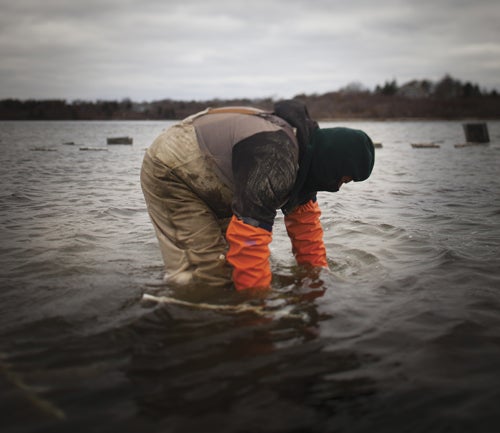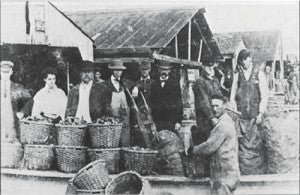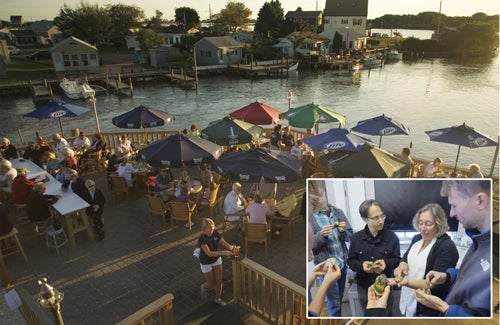The Oyster is Their World

By Ellen Liberman
The sun, long hidden by a spate of February storms, had warmed the day to a toasty 28 degrees. A blaze of orange on the edge of South Kingstown’s Potter’s Pond was a knot of oystermen in foul weather gear, bringing in the morning’s harvest: six thousand oysters in mesh bags, nestled in plastic tubs atop the deck of an aluminum barge, bound for the New York and Philly fish markets. About a third of the Eastern oysters pulled from Perry Raso ’02, M.S.’06’s seven-acre farm make a much shorter journey—a right at the top of the gangway into his restaurant, where, splayed on a bed of ice, they tempt diners.
In 2002, Raso was a newly minted graduate of URI’s Aquaculture Program, and an oyster farmer. One of just 18 in the state, he was growing oysters in the shallows, three years away from producing a market-sized crop.
“I had nothing,” he recalls. “I was digging wild quahogs and steamers to earn a day’s pay.”
“You can see Rhode Island oysters on the menu at a restaurant in L.A. and that’s incredibly good for our economy.”
Perry Raso ’02, M.S. ’06
Today, he harvests a million oysters annually and employs more than 200 at the season’s height, tending, sending and serving oysters. Six years old, the Matunuck Oyster Bar is still South County’s hot restaurant ticket, making Raso the most visible symbol of Rhode Island’s fastest growing industry.
“Our oysters go all over. You can see Rhode Island oysters on the menu at a restaurant in L.A. and that’s incredibly good for our economy,” Raso says. “There have been growing pains every step of the way. But there’s still room to improve. We have a long way to go.”
Last year, Rhode Island farmers harvested more than $5 million worth of oysters, eclipsing the wild harvest of quahogs. The number of farms has grown to 55 in 2014; another eight lease applications are somewhere in the Coastal Resources Management Council’s (CRMC) pipeline.
Oysters are having a moment—thanks to the local food movement and the farm-to-table restaurant trend. Their flavor influenced by the unique environment in which they are cultivated, oysters are tasted for terroir, like fine wines. But oyster aquaculture in Rhode Island owes its success to strong partnerships among growers, state officials and the academic community. URI, many acknowledge, has been key.
Brian Pinsky ‘10, a graduate of URI’s aquaculture program who opened his 401 Oyster Farm last May on three acres of Ninigret Pond, credits the university with “introducing me to a lot of people who are experts. It gave me good connections for people who helped me along the way.”
Faculty research has shaped regulation and husbandry practices. Staff coordinated the creation of the state shellfish management plan and the disbursement of $1.5 million in federal funds to further state aquaculture. URI graduates make up a significant slice of the state’s farmers and they lead the industry trade associations on both coasts.
“It’s an industry with no downside and significant environmental benefits. Oysters clean the water and create habitat. You can grow oysters with a modest investment and produce sustainable local domestic seafood while working on the water,” says Robert “Skid” Rheault, M.S. ’85, Ph.D.’95, executive director of the East Coast Shellfish Growers Association, who earned his doctorate in biological oceanography and is adjunct faculty at URI. “Oysters are the number one seafood product landed in Rhode Island waters—and we’re doing it on less than 200 acres. That’s big news.”

Not bad for an industry left for dead in the 1950s. At its height in 1911, oyster farms covered about a third of Narragansett Bay’s bottom, says Michael Rice, aquaculture professor in the Department of Fisheries, Animal and Veterinary Science.
“Those 21,000 acres were controlled by seven companies, and very much like any of the businesses of that era, run like a textile mill town, with occasional company housing and shopping at the company store,” says Rice. “Then, a whole series of misfortunes—environmental, political and historical—came together to bring down the industry. The last of the big oyster farms closed in 1954.”

Rheault was among the pioneers who brought oyster aquaculture back. In the late 1980s, after a brief stint growing scallop seed, Rheault turned to growing oysters in Point Judith Pond.
“The regulations were not conducive,” he recalls. “It took me two-and-a-half years to get a three-acre lease. There were 600 letters of objections in my file. A rational person would have moved on…I used to say that the future of aquaculture in Rhode Island is in Connecticut.”
Building a Better Oyster
Farmers have relied on vaccines to protect their livestock from disease since 1881, when Louis Pasteur inoculated 70 sheep with an attenuated form of the anthrax bacillus in a public demonstration of his new virus vaccines. But oyster farmers need to take an even older approach to herd immunity.
“Oysters do not have immune systems like those present in vertebrates. Shellfish don’t have the ability to recognize a pathogen that they encountered long ago and respond faster,” explains Marta Gomez-Chiarri, professor and chair of URI’s Department of Fisheries, Animal & Veterinary Science. “With oysters and shellfish, you need to use other tools like selective breeding.”
Gomez-Chiarri, who came to URI in 1997 as a shellfish pathologist, studies disease resistance in oysters, searching for the unique genetic signature that boosts the survival rate, despite pathogenic threats.
The Eastern Oyster, Crassostrea virginica, is susceptible to four major diseases: Juvenile Oyster Disease, caused by a bacterium, and Dermo, MSX and SSO, all caused by parasites. In a bad year, any one of them can devastate the wild or cultured population. Gomez-Chiarri has assumed the exacting task of following the trail of genes an oyster expresses when exposed to a pathogen. Without the aid of genetic science it would take many years, and many generations to develop the most disease-resistant oyster lines.
“By knowing the mechanism, you can selectively breed faster and in a more targeted way,” she says. “How do you find the resistance genes? That’s a lot of work. One of the approaches that you can use is looking at every gene expressed in response to pathogens in both resistant and non-resistant populations. By comparing the two, you have a long list of genes that you try to narrow to those that are really responsible.”
Disease-resistant lines can help a shellfish restoration succeed, or a farmer turn a profit. And while Gomez-Chiarri tries to break the code of disease resistance, oyster farmers bring in their ailing stock for diagnosis, and she sends them off with suggestions on different lines to try out.
“We work closely together and share data,” she says. “They recognize that the knowledge helps and I learn from them as much as they learn from me.” •
But Rheault’s troubles marked a turn-around. The Ocean State Aquaculture Association was formed to educate policymakers about the regulatory obstacles. Their efforts caught the attention of State Representative, and then-CRMC member, Eileen S. Naughton, who led the General Assembly to streamline regulations in 1996. URI is still heavily involved in crafting shellfish aquaculture policy. Under the guidance of URI’s Coastal Resources Center and Rhode Island Sea Grant, the state completed its first shellfish management plan. In November, the Department of Environmental Management and the CRMC signed an agreement to cooperate on shellfish management strategies.
“The first version is done and we’ve already implemented many of the actions,” says Jennifer McCann M.S.’94, the Coastal Resources Center director for U.S. Coastal Programs. “But we’re continuing to work on aquaculture regulation, and the plan will be constantly updated as we have new research and recommendations.”
Oystering’s resurgence has also created conflicts. Established farmers like John and Cindy West ‘95, URI graduates who bought Moonstone Oysters from Rheault in 2007, worry that a new breed of aquaculture hobbyists—lessees with other full-time professions—will not take the kind of care necessary to protect their harvest from Vibrio vulnificus, a bacterium that can infect raw oysters and cause serious illness.
“Everybody thinks you’re printing money and it looks really neat,” says John West. “But it’s self-policed and if someone doesn’t follow the guidelines, they can shut everyone else down.”
Elsewhere, aspiring lease-holders are meeting resistance from other fishermen and coastal property owners who argue that aquaculture interferes with other uses. Under current regulations, up to 5 percent of each coastal pond can be put into production. No pond is close to that cap.
“The 2009 regulation was based on the best science available at that time,” says Dave Beutel ’92, the CRMC’s aquaculture coordinator. “It was an ecological capacity. But, that was much too low of a cap, so the limit is not an environmental limit. It’s a social limit.”
Recently, for example, there were numerous objectors to three lease applications in Quonochontaug Pond.
“We support aquaculture, as long as it’s properly cited and properly operated,” says Art Ganz, M.S.’74, president of the Salt Pond Coalition, which opposed them. “We’re trying to strike a compromise for multiple uses within the salt ponds.”
These disputes have become common in Washington state, where, despite a long history of oyster aquaculture, new permits are now rare. Margaret Pilaro Barrette ’92, M.S.’97, executive director of the Pacific Coast Shellfish Growers Association, says that her undergraduate and master’s degrees in marine affairs amply prepared her.
“Marine affairs, and the real-world experiences I had at URI, gave me the ability to recognize the potential for conflict but more importantly taught me how to navigate toward the best outcome,” she says.
To farm is to do battle—with pests, the government, the elements, and sometimes the neighbors. The future of Rhode Island aquaculture may be out in the bay.
“There’s a good reason why everyone’s not a farmer. It’s a challenging industry—the uncertainty from season to season,” says Cindy West. “You have to have the stamina to carry on. But I love it. It’s working on the earth and nature and it gives you an appreciation for when things are going well.”
This winter was tough, with brutal lows encasing the ponds in thick crusts of ice. But the market doesn’t much care; it still wants its oysters. Graham Brawley ’02, manager of the Ocean State Shellfish Cooperative, waited dockside to escort this harvest into the box truck idling in the parking lot of the Matunuck Oyster Bar. Founded in 2007, with six farms covering 50 acres, the cooperative is comprised of farmers who got at least some of their formal aquaculture schooling at URI.
“Cooperative is a bad word in the state of the independent man,” Brawley says. “But in the end, we came together—a group of guys with a common goal, to distinguish ourselves regionally as growing the best shellfish on the planet.”
Come spring, when all six of the farms are cranking, they’ll see harvests of 30,000 oysters in a single morning. But today, a few thousand will have to do. Each worker grabs one end of a gray tub and, man-to-man, they form a line to unload the oysters from the barge to the truck, like links in a chain of Rhode Island tradition. •
 Home
Home Browse
Browse Close
Close Events
Events Maps
Maps Email
Email Brightspace
Brightspace eCampus
eCampus


